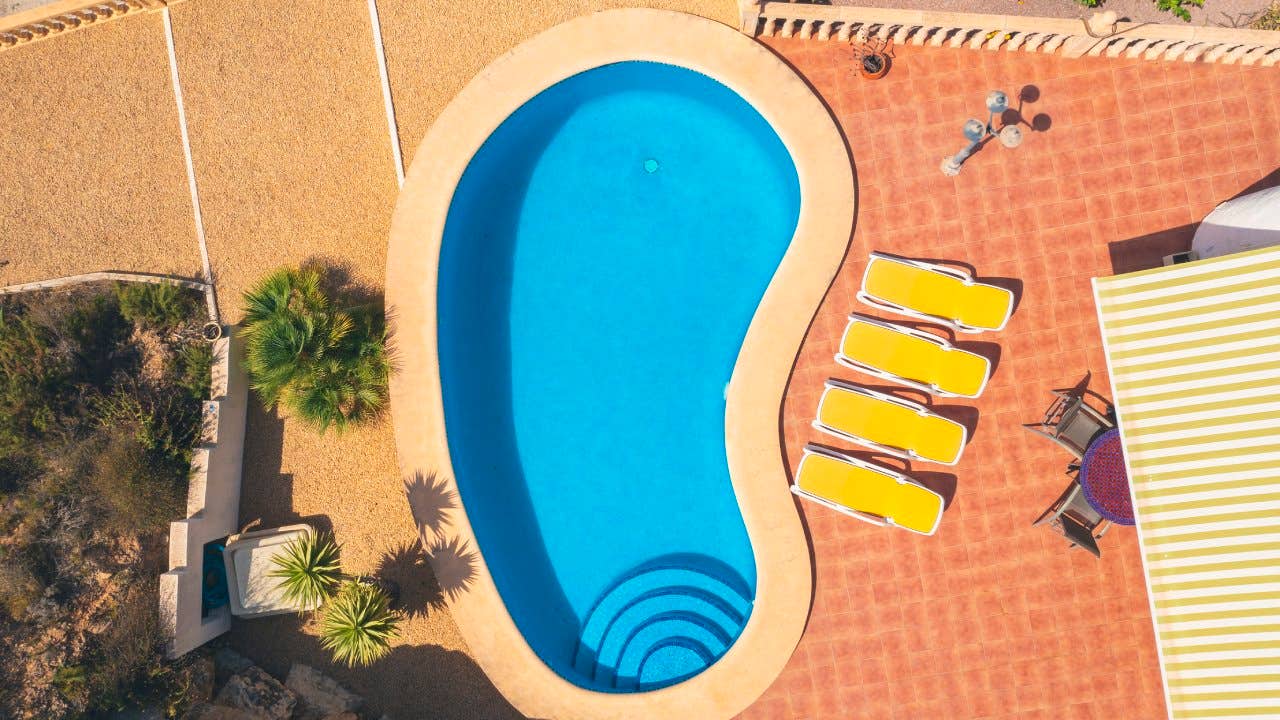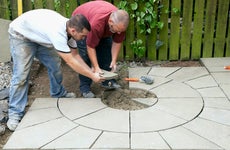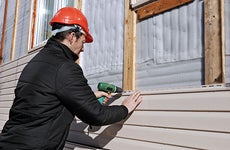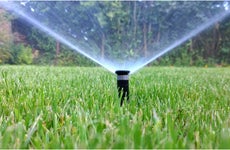What’s the cost to install a swimming pool?

The Bankrate promise
At Bankrate we strive to help you make smarter financial decisions. While we adhere to strict , this post may contain references to products from our partners. Here's an explanation for .
With summertime approaching you may be thinking about how nice your own watering hole could be — a personal pool to lounge around and splash about in.
First off, you should know this is not a DIY job for almost anyone. A swimming pool is a complex thing to install, and different localities have different regulations about exactly what you can and can’t do.
Second, you better be ready to dive deep into your pockets before you can dive into the deep end. For an in-ground or built-in swimming pool — the permanent kind that requires a large hole to be dug in your yard — you can expect to spend $35,000-$100,000 for installation and add-ons like decking, depending on the size, material and layout you choose, according to HomeAdvisor. Larger, more complicated designs, intricate finishes and elaborate landscaping will, of course, up the cost; it’s not unheard of to spend six figures on swimming pools.
So let’s dig into the basics of in-ground pools.
In-ground pool vs above-ground pool
But first, let’s briefly discuss in-ground vs. above-ground pools, their cost, and the value they bring to your home.
Generally, an above-ground pool — essentially, a big tank with water in it — is quicker and much less expensive to build, making them a smart choice for cost-conscious homeowners. HomeAdvisor estimates the cost of installation and add-ons like decking is around $5,000 – $25,000. Maintaining an above-ground pool is typically cheaper than maintaining an in-ground pool, too, with annual costs around $1,000 – $1,200 vs. $1,000 – $4,000, respectively.
While it may be less expensive to install and maintain an above-ground pool, though, cheap is cheap. In-ground pools will typically add more value to your home than their above-ground counterparts, because they’re an intrinsic fixture to the home (you can’t take it with you when you move). Above-ground pools, by contrast, are temporary, and not even included in home appraisals. In fact, unless you live in a hot, particularly pool-crazy region, the above-ground version often doesn’t add any value at all, many real estate professionals claim.
What are the main types of in-ground swimming pools?
When it comes to in-ground pools, one of the first decisions you’ll have to make is what material you want yours to be made of.
The three most common types are concrete/gunite, vinyl-lined and prefabricated fiberglass.
According to HomeAdvisor, vinyl-lined pools are usually the cheapest option up-front, but may have higher maintenance costs over time, because the liner usually needs to be replaced every 10 years or so. Meanwhile, fiberglass pools are more expensive to install but cheaper to maintain. Old-fashioned concrete and gunite pools are the most customizable, but have high installation and maintenance costs.
| Pool type | Installation costs | Maintenance info |
|---|---|---|
| Concrete/gunite | $55,000 – $100,000 | $2,700 – $4,000 annual maintenance costs, but lasts the longest with proper care — up to 100 years |
| Fiberglass | $45,000 – $85,000 | $1,000 – $1,500 annual maintenance costs, but long-lasting and easy to clean |
| Vinyl-lined | $35,000 – $65,000 | $1,100 – $1,700 annual maintenance costs, plus the liner needs to be fully replaced about once every 10 years |
What influences the cost of installing a swimming pool?
No two pool projects are exactly the same, and your construction and installation costs will depend on where you live, your property’s geography and your pool’s specs.
It’s generally cheaper to build a pool in warmer-weather states, where personal watering holes are more of an everyday feature, and supplies and contractors are more plentiful. There are less likely to be delays due to weather, as well.
No matter what they’re made of, larger pools are generally more expensive to install, and local regulations including permitting costs and debris disposal can also influence the price.
The features you choose for your pool will also influence the cost: Unusual shapes (beyond the classic rectangle or kidney outline) tend to be more expensive to install. Add-ons like waterfalls and hot tubs will also up the cost — by at least $2,000 to $17,600, according to HomeGuide.
Beyond the pool itself, various additional details can influence the overall cost of the project. If you’re using the pool installation as a reason to spruce up your property, say with a new deck, expensive patio pavers, landscaping or even a pool house, you’ll want to make sure to budget accordingly.
Keep in mind, most municipalities require fences to go up once a pool goes in, which can add a few thousand more dollars to your project, depending on the size of your property, fence materials you choose and specific local requirements. For example, if your city or town requires self-closing gates, you’ll pay more. In general, you can expect to pay $600 – $4,400 to install a fence, according to HomeGuide.
What’s popular in pools?
Pools are like almost every other home renovation or design project in that trends for finishes and features shift over time.
Here are some things that are hot in new pools today:
- Saltwater filtration — with the price of chlorine rising, more and more pool owners are choosing saltwater systems over the ones that use traditional chemicals. While these can be a little more expensive to install (up to $2,200 more for the saltwater generator, according to HomeGuide) and maintain, they require less attention day-to-day than chlorine pools do.
- Tanning shelves and benches — as pool owners look for ways to get more functionality out of their investment, tanning shelves (a large, shallow area where recliners can be partially submerged) and perimeter benches are gaining popularity.
- Different shapes — while rectangular pools remain popular because they’re the easiest and most affordable to install, homeowners with a bigger budget or more space can explore more intricate designs from freeform geometric layouts to classic Roman ends.
- Smart pool systems — the internet of things has come to the backyard swimming arena, too. Why rely on timers and switches when there’s an app for monitoring your chemical levels or controlling your heater or switching on the underwater lights from your phone?
“Automation in general is becoming more prevalent in the field,” says Jay Vogt, owner of Sherwin Pools in Massapequa Park, New York. “You can shut things off on your phone. A lot of this stuff I find is becoming more common, it’s going to become unavoidable.”
Does a pool add value to your home?
Traditional wisdom once held that a pool is more of a liability than a benefit when it’s time to resell your home.Many house-hunters just don’t care about swimming all that much. Or, they shy away from the extra responsibilities and costs, making your potential purchasers pool (pun intended) smaller.
But that calculation has been shifting, especially since COVID-19 caused people to hunker down in their homes. In the Top Agent’s Insights Report for 2021, Homelight’s real estate pros estimated that prior to pandemic, a house with a pool fetched, on average, an estimated $16,137 more than a house without one; as of spring 2021, a house with a pool could sell for $27,199 more on average, they estimated.
“Over the past few years due to the trend of [using] more outdoor space, pools have been exceptionally popular with buyers paying a premium to get those homes,” says Kevin Kieffer, broker associate with Compass Walnut Creek in the San Francisco Bay area. Buying a home without a pool and then building one is often significantly more expensive than buying a property with an existing pool, he adds.
Seven percent is usually the magic number associated with the additional value a pool brings. That’s usually less than the price to build one: Pools typically recover only 56 percent of the installation cost, according to the National Association of Realtors’ “2023 Remodeling Impact Report: Outdoor Features.”
However, understanding your neighborhood is key when it comes to evaluating the resale value of a pool: If all of your neighbors have one and you don’t, your property may not command as high a price when you’re ready to sell.
You have to know your market as well. “There are buyers that absolutely have to have one and buyers that definitively do not want one,” Kieffer says.
Bottom line on installing a pool
A built-in pool is a big investment for homeowners to make. They’re expensive to install and have fairly high ongoing maintenance costs. But they’re still as popular as ever — if not more so — and many find that the costs are worth it for the fun they get in return.
If you’re considering adding a pool to your property, make sure to solicit multiple bids and get a good handle on your budget before the excavators dig in.
Related Articles



